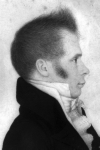 I recently found myself reading an 1842 guide to Washington D.C., written by none other than George Watterston (pic), one of my personal favorite Capitol Hill characters. I turned, as always, to the parts describing the Hill, and found my way to the description of the Library of Congress. After a description of the room, its contents, and how they were arranged, it returned to its origins, and how it was restarted after the burning of Washington in 1814:
I recently found myself reading an 1842 guide to Washington D.C., written by none other than George Watterston (pic), one of my personal favorite Capitol Hill characters. I turned, as always, to the parts describing the Hill, and found my way to the description of the Library of Congress. After a description of the room, its contents, and how they were arranged, it returned to its origins, and how it was restarted after the burning of Washington in 1814:
The total loss of the library induced Mr. Jefferson to offer his collection to Congress, which forms the substratum of the present valuable library. His books may be distinguished by a private mark. Whenever the printer’s signature occurs at the bottom of the page as a J, he has put T before it, and when T occurs he puts J after it, so to form the initials of his name.
Intrigued by this information, I turned to a general search to see if anyone else had ever commented upon this, or whether it was simply a figment of Mr. Watterston’s imagination. I came up empty. I then turned to the Library of Congress website itself, and, after a few false starts, found myself on a page that linked to a scanned copy of Jefferson’s own copy of The Federalist Papers (or, as the title page has it: “The Federalist: A Collection of Essays Written in Favour of the New Constitution as Agreed Upon By the Federal Convention, September 17, 1787”)
Even before getting to the initials as described by Watterston, there are some remarkable inscriptions in the book: on one of the blank pages at the beginning thereof, there is a list of all the chapters, and the guess as to whether they were written by John Jay, James Madison, or Alexander Hamilton. Below that, two people have added a note that they believe that the above list was written by none other than Jefferson itself.
The title page then has written across the top of it “For Mrs. Church from her sister Elizabeth Hamilton” Elizabeth Schuyler Hamilton was indeed the wife of Alexander Hamilton, and her sister was Angelica Schuyler Church. Across the bottom, in pencil, is the notation “Mr. Jefferson’s copy.”
6 pages on, on page 1 there is what appears to be an extraneous A at the bottom of the page, while page 3 has an A2, page 5 an A3 and page 13 a B. This pattern continues throughout the book. These letters are printer’s marks and are used to keep track of the pages when they are being collated after printing.
Thus, page 113 has an I at the bottom – and there is indeed a T added before it in pen. (There is no J in printer’s marks, for reasons that will be well-understood by readers of my books. ) And page 233 has a J added after the T that graces the bottom of the page.

Details of page 113 and 233 from Jefferson’s copy of The Federalist Papers (LOC)
It is thus clear that Watterston, –who was Librarian of Congress for many years, including when the Jefferson library was acquired– was 100% correct in his assertion.
For me, it is just unfortunate that printer’s marks are no longer necessary when printing and binding books, or I would be going through my whole collection of books and adding R’s, S’s, and P’s to the appropriate pages in each one.
